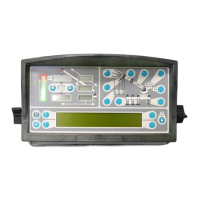MICROGUARD RCI 510 TROUBLESHOOTING MANUAL 12 W450260D 03/10
2.4.2 DISPLAYED LOAD OR RADIUS ERRORS
This section gives direction to fault diagnosis of load and radius errors as displayed on the display
console. Load or radius errors may give rise to early or late tripping of overload alarms. Accuracy
of load, radius, length, and angle is determined by the correct installation and maintenance of the
system sensors. Accuracy of load is governed by the radius accuracy, and the extension, angle, and
pressure sensors. Accuracy of radius (unloaded) is governed by the extension and angle sensors.
Before continuing, make sure that there are no system faults.
CHECK BOOM EXTENSION
1. First check that the boom is fully retracted.
2. Check that the extension reel-o cable is correctly layered as a single layer across the extension
reel surface. Any stacking of the cable will cause extension errors when the boom is fully retract-
ed, causing the System to exceed the 0.5 ft tolerance allowed by the computer for boom mode
selection. If the reel-o cable is stacking on the reel, see SECTION 6.2.
3. Check the zero of the extension sensor at the fully retracted boom position. Enter the Calibration
Mode and use the “SPAN” command. Select sensor No. 2 to view the extension value in feet. The
value of extension must be between -0.2 and +0.2, with the boom fully retracted. If the exten-
sion value is incorrect, follow the EXTENSION SENSOR SETUP procedure in SECTION 6.5. Fully
telescope the boom and check that the displayed boom length value matches the maximum
length of the boom. If the length value is incorrect, follow the EXTENSION SPAN procedure in
SECTION 6.5.3.
CHECK MAIN BOOM RADIUS
1. Fully retract the boom and make sure that the crane conguration is correctly set up.
NOTE: THE REQUIRED ACCURACY OF TAPED RADIUS MEASUREMENTS IS WITHIN 0.1 FEET. WHEN TAK-
ING RADIUS MEASUREMENTS ALWAYS USE A GOOD QUALITY TAPE THAT DOES NOT STRETCH. THE
TAPE SHOULD BE GRADUATED IN FEET AND TENTHS OF A FOOT. ALWAYS MEASURE BETWEEN THE
SWING CENTER OF THE CRANE AND THE HOOK LINE, USING A SINGLE PART OF LINE WITH THE CRANE
CENTERED OVER FRONT (ROUGH TERRAIN) OR CENTERED OVER REAR (TRUCK CRANE).
2. Boom up to about 45° and measure the radius. The measured radius must match the displayed
radius within +/- 0.2 ft. If it does not match, continue to the “CHECK BOOM ANGLE” procedure. If it
does match, continue to “CHECK PRESSURE SENSORS.”
3. Boom up to a high angle (at least 70°) and measure the angle with the inclinometer. Check that
the displayed angle matches the inclinometer reading within 0.2°. If the displayed angle is incor-
rect, follow the angle span calibration procedure in SECTION 6.9.3.

